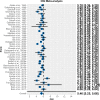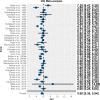A systematic meta-analysis of oxygen-to-glucose and oxygen-to-carbohydrate ratios in the resting human brain
- PMID: 30248124
- PMCID: PMC6152967
- DOI: 10.1371/journal.pone.0204242
A systematic meta-analysis of oxygen-to-glucose and oxygen-to-carbohydrate ratios in the resting human brain
Abstract
Glucose is the predominant fuel supporting brain function. If the brain's entire glucose supply is consumed by oxidative phosphorylation, the molar ratio of oxygen to glucose consumption (OGI) is equal to 6. An OGI of less than 6 is evidence of non-oxidative glucose metabolism. Several studies have reported that the OGI in the resting human brain is less than 6.0, but the exact value remains uncertain. Additionally, it is not clear if lactate efflux accounts for the difference between OGI and its theoretical value of 6.0. To address these issues, we conducted a meta-analysis of OGI and oxygen-to-carbohydrate (glucose + 0.5*lactate; OCI) ratios in healthy young and middle-aged adults. We identified 47 studies that measured at least one of these ratios using arterio-venous differences of glucose, lactate, and oxygen. Using a Bayesian random effects model, the population median OGI was 5.46 95% credible interval (5.25-5.66), indicating that approximately 9% of the brain's glucose metabolism is non-oxidative. The population median OCI was 5.60 (5.36-5.84), suggesting that lactate efflux does not account for all non-oxidative glucose consumption. Significant heterogeneity across studies was observed, which implies that further work is needed to characterize how demographic and methodological factors influence measured cerebral metabolic ratios.
Conflict of interest statement
The authors have declared that no competing interests exist.
Figures




References
-
- Gibbs EL, Lennox WG, Nims LF, Gibbs FA. Arterial and cerebral venous blood arterial-venous differences in man. J Biol Chem. 1942;144: 325–332.
-
- Lennox WG, Leonhardt E. The respiratory quotient of the brain and of extremities in man. Arch Neurol Psychiat. 1931;26: 719–724.
-
- Shenkin HA, Harmel MH, Kety SS. Dynamic anatomy of the cerebral circulation. Arch Neurol Psychiat. 1948;60: 240–252. - PubMed
-
- Kety SS. The General Metabolism Of The Brain In Vivo. In: Richter D, editor. Metabolism Of The Nervous System. London; 1957. pp. 221–327.
Publication types
MeSH terms
Substances
Grants and funding
LinkOut - more resources
Full Text Sources
Other Literature Sources

